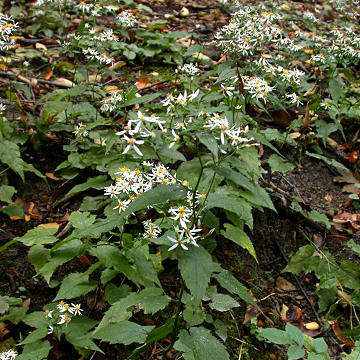

Eurybia divaricata - (image 1 of 6)
Taxonomy
Family: Asteraceae
Synonymous with Aster divaricatus L.
Habitat
Woods.
Associates
Distribution
Northern NH and southwest Quebec west to southern Ontario, south to DC and southern OH, and in mountains to northern GA and eastern AL.
Morphology
Perennial, 20-100 cm (rarely that tall), colonial by creeping rhizomes. Stem puberulent, at least in the inflorescence. Leaves thin, sharply serrate with mucronate teeth, glabrous or sparsely hairy, cordate at the base, acuminate, to 20 cm long, petiolate; middle and upper leaves becoming progressively reduced, less cordate and with shorter petioles. Inflorescence corymbiform, sometimes elongate, with few and often broad bracts; involucre 5-10 mm with firm, imbricate, rounded to acute bracts that are mostly whitish with green tips; outer involucral bracts to 1.5 mm wide and rarely more than 2.5 imes as long; ray petals white or lilac-tinged, 5-16.
Notes
Flowers: August and October
Wetland indicator: NA (Facultative Upland?)
A common fall-blooming aster of northeastern woodlands. This species is often lacking in forests that have established on sites with a history of agriculture.
References
Gleason, Henry A. and A. Cronquist. 1991. Manual of Vascular Plants of
Northeastern United States and Adjacent Canada. Second Ed.
The New York Botanical Garden. Bronx, NY
|
Michael Hough © 2009 |